Today, I am hosting chapter 16 of Literacy Beginnings (Fountas & Pinnell) for the Book Study Blog Party.
Chapter 16: Using Shared and Interactive Writing: Writing to Develop Emergent Writers
Definitions to Remember for this Chapter:
- Shared and interactive writing is when you and the children write a story, chart, or class book together.
- Shared writing is when the teacher uses the pen.
- Interactive writing is when the teacher “shares the pen” with the children.
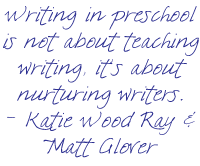 Sharing the pen with young children means that you are writing (scribing) most of the message, while asking children to help with small parts of the message. A teacher could ask a child to write one letter, hold their hand on paper for a space between words, write a word they know (like mom or dad), or write their own name. The authors recommend not spending too much time sharing the pen. If too much time is spent having individual children come up to write something, you will lose the attention and interest of the rest of the class. The authors also suggested sharing the pen while making a class book which could be done in a small group rather than a large group. To share the pen in the making of a class book, you could have the child write their name and perhaps the first letter of another word.
Sharing the pen with young children means that you are writing (scribing) most of the message, while asking children to help with small parts of the message. A teacher could ask a child to write one letter, hold their hand on paper for a space between words, write a word they know (like mom or dad), or write their own name. The authors recommend not spending too much time sharing the pen. If too much time is spent having individual children come up to write something, you will lose the attention and interest of the rest of the class. The authors also suggested sharing the pen while making a class book which could be done in a small group rather than a large group. To share the pen in the making of a class book, you could have the child write their name and perhaps the first letter of another word.
There is a comprehensive list on page 154 of types of writing that Pre-K children will likely be able to do. This list is a good guide for brainstorming ideas for shared and interactive writing.
“Draw and write about experiences.” A great way to accomplish this is through bookmaking, which takes the place of journals. Rather than write one page in a journal, children make a book. The book can be a work in progress, it does not have to be written all in one day. Katie Wood Ray and Matt Glover are the experts on bookmaking with preschoolers. You can read more about it in their book, Already Ready, which I highly recommend. I also wrote a summary about bookmaking a couple of years ago (I’ll try not to repeat myself). Another way to have children write about experiences with shared or interactive writing is to make a chart story about a field trip or class pet.
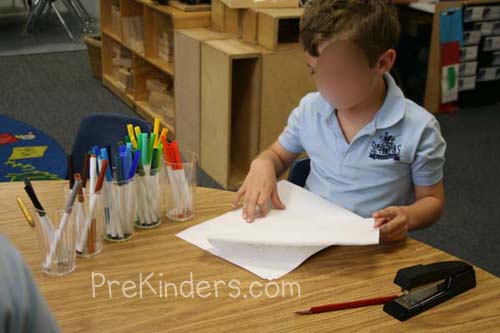
“Make up stories and draw to represent the events (in sequence).” This can also be accomplished through bookmaking.
“Use aspects of print such as speech bubbles, punctuation, titles.” I teach my students about speech bubbles and thought bubbles using the Pigeon books by Mo Willems. We often make our own Pigeon books where I encourage children to use a speech bubble or thought bubble, and the children often make those on their own without my suggestion.
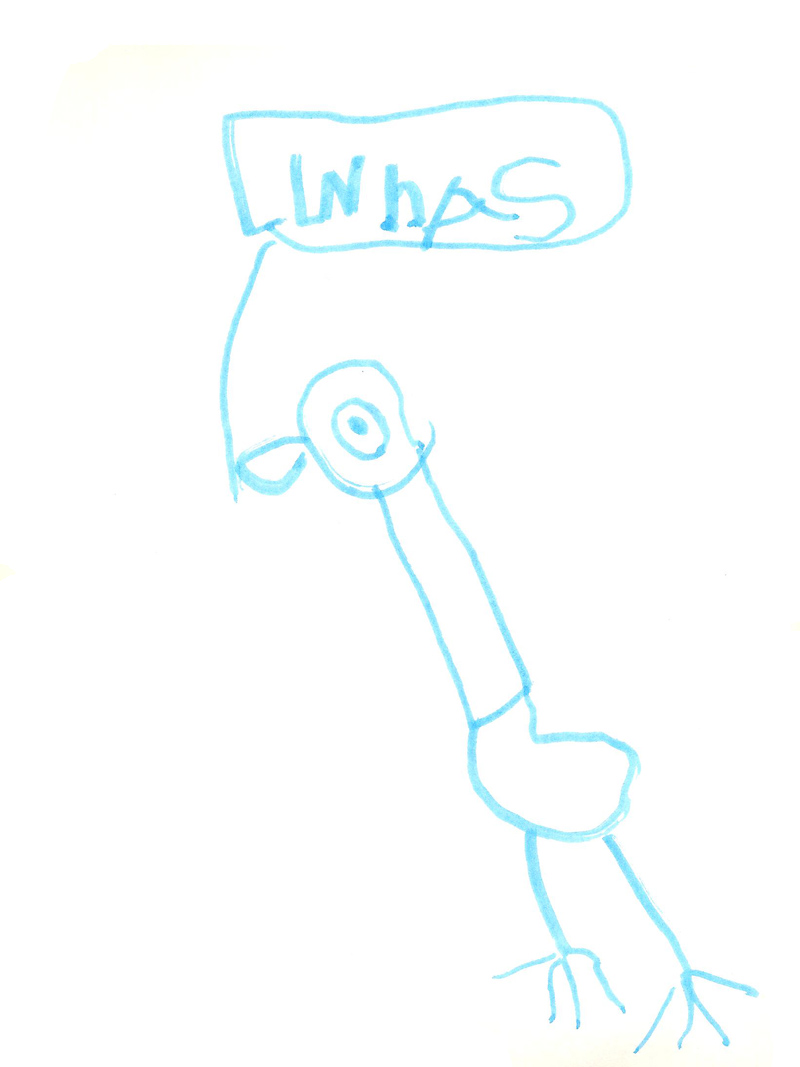
“Make menus, receipts, signs, and other functional items.” This is where the dramatic play center comes in handy. Have the children help you create a restaurant, flower shop, ice cream shop, or let the children decide which type of store or shop they would like to create. Have the children make their own menus and signs for the shop. Cut long, narrow strips of paper for children to write receipts.
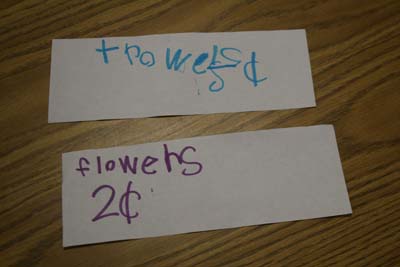
“Retell stories with series of pictures.” You can buy a second copy of a book, pull out the pages, laminate, and have children sequence and retell the story (use about 3-5 pictures). For many books you can also collect or make mini props for retelling a story.
When we respond to literature, I often have the children draw a picture on a piece of paper, they retell the story to me in their own words, and I write it at the bottom of the page. I look to see if the child includes only one part of the story or many parts, how many details they include, and whether their retelling is true to the story (some children add things that did not happen). I look for those things simply to compare their retellings throughout the year, because all children show some progression.
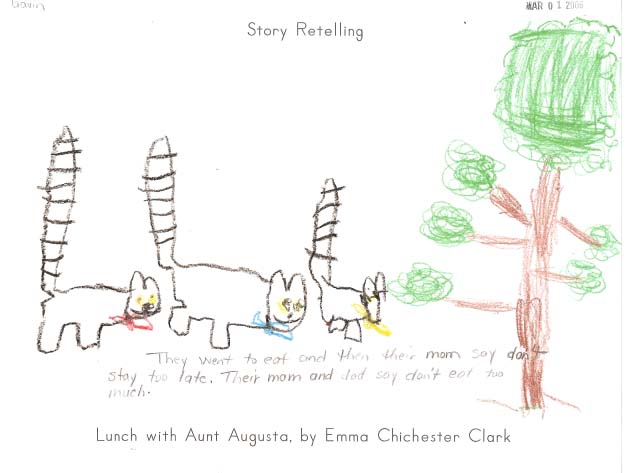
“Make a book that reflects story or informational text.” Bookmaking again. When children make books, you can encourage them and explain how to make different types of books (genre, in grown up words): information, fiction stories, true stories about their lives, and others. They will learn how to write different types of books by having these books read to them.
Wood and Ray (Already Ready) suggest encouraging preschoolers to make books by writing books yourself (yes, you), and read them to the children. You don’t have to write like Isak Denisen or draw like Jan Brett. In fact, it’s better if the words and pictures are simple. The purpose is simply to show children that authors are real people and anyone can write.
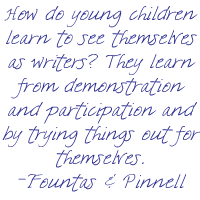 To encourage children to make books, constantly remind them. Make a suggestion after you read a book to the group, e.g. “We just read an information book, a book that teaches us facts about something. Perhaps you could make an information book today.” Or, “This book was about frogs. You could make a book about frogs. It could be facts about what frogs eat and where they live and what they do, or a make believe story about frogs.” Be sure to remind them about bookmaking after school has been out for a holiday.
To encourage children to make books, constantly remind them. Make a suggestion after you read a book to the group, e.g. “We just read an information book, a book that teaches us facts about something. Perhaps you could make an information book today.” Or, “This book was about frogs. You could make a book about frogs. It could be facts about what frogs eat and where they live and what they do, or a make believe story about frogs.” Be sure to remind them about bookmaking after school has been out for a holiday.
Have a bookmaking area in the class room (it can be part of the writing center). Include blank books and writing materials as well as space for children to store their works in progress. Allow children to place their finished books in the reading center along with other books to show them that their writing is just as important as other books. Vanessa at Pre-K Pages also has more information about interactive writing on her Morning Message page.
What are some ways you include shared writing and interactive writing into your preschool classroom? Do you include it in your daily routine?
Have comments of your own about chapter 16? Be sure to post a comment below. If you write a response on your blog, be sure to add your link to the Linky party below. Chapter 17 will be hosted by Eilis Meyer at Growing in Pre-K. Don’t miss it!
